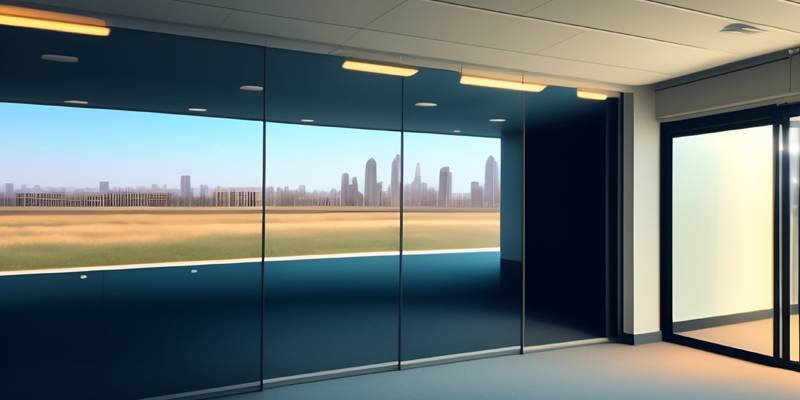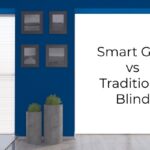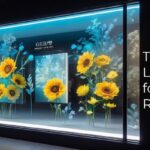In recent years, there has been a growing trend in architecture to incorporate smart technologies that can reduce energy consumption, improve indoor comfort, and enhance aesthetic appeal. One of the most innovative technologies that have emerged in this field is electrochromic glass. This type of glass has the ability to change its tint and optical properties in response to external stimuli such as light, heat, or voltage. In this article, we will explore how electrochromic glass is revolutionizing architecture and what benefits it brings to the built environment.
Electrochromic Glass?
It is a type of smart glass that can change its optical properties in response to an electrical current. Electrochromic glass consists of multiple layers of thin films that contain electrochromic materials. These materials, such as tungsten oxide or nickel oxide, are sandwiched between two transparent conductive electrodes. When a voltage is applied across the electrodes, ions migrate between the layers. This migration causes the glass to change its tint from transparent to opaque or to a specific color.
How Does Electrochromic Glass Work?

The working principle of this glass is based on the electrochromism phenomenon. This phenomenon is the reversible color change of a material induced by the injection or extraction of ions.
In electrochromic glass, the electrochromic layers are activated by an electric field. This electric field causes the migration of ions between the layers. Controlling the color and transparency of the glass is possible by varying the voltage and duration of the electrical pulse.
Advantages of Electrochromic Smart Glass for Architecture
Energy efficiency: It can reduce the need for artificial lighting, heating, and cooling by regulating the amount of solar heat and light that enters the building.
Comfort: It can provide a more comfortable indoor environment by reducing glare, heat gain, and UV radiation.
Aesthetics: It can enhance the aesthetic appeal of the building by creating dynamic and interactive facades that respond to the changing environment.
Privacy: It can provide privacy and security by allowing the occupants to control the transparency of the glass.
Sustainability: It can contribute to the sustainability of the building by reducing its carbon footprint and energy consumption.
Applications of Electrochromic Smart Glass in Architecture
Facades: Creating dynamic and responsive facades is possible using these glasses. The facades can change their appearance and performance based on the time of day, season, or weather conditions.
Skylights: The use of these glass in skylights enables regulation of the amount of natural light and heat that enters the building.
Windows: You can use these types of glass in windows to improve energy efficiency, reduce glare and UV radiation, and provide privacy and security.
Partitions: Architects and designers can use these glasses to create flexible interior partitions.
Electrochromic Glass vs Traditional Glazing Systems

Better energy performance: It can significantly reduce energy consumption by minimizing heat gain and loss. Traditional glazing systems may require additional shading devices or HVAC systems to achieve similar results.
Improved comfort and well-being: It can enhance indoor comfort and well-being. It regulates natural light and reduces glare and heat gain. This can lead to improved productivity and health.
Greater design flexibility: It allows for greater design flexibility. It provides dynamic and interactive facades that can change their appearance and function in response to the changing environment. In contrast, traditional glazing systems offer limited options for customization and visual interest.
Case Studies of Electrochromic Smart Glass in Buildings
Several buildings around the world have incorporated these glasses to improve their energy performance and aesthetic appeal. Here are some examples:
The Sage Gateshead in the UK boasts a 25-meter-high glass facade. The glass facade has the unique ability to change color and transparency based on the weather and time of day.
The National Research Council of Canada’s new building in Ottawa has these glass curtain walls. The curtain wall can adjust its tint based on the amount of sunlight and glare it receives.
The Department of Energy’s new office building in Washington, DC, has these glass windows. These windows can adjust their tint based on the occupancy and lighting conditions inside the building.
Future of Electrochromic Smart Glass in Revolutionizing Architecture

The future of electrochromic smart glass in revolutionizing architecture looks bright.
Here check how the Future of Electrochromic Smart Glass is Revolutionizing Architecture
Demand for sustainable buildings: We expect the use of this glass to grow due to the increasing need for sustainable and energy-efficient buildings.
Advancements in materials and technologies: We expect that new materials and technologies will enhance this glass in architecture. These materials include hybrid electrochromic photovoltaic windows and self-cleaning glass. The experts predict that these new technologies will improve the performance and functionality of this glass in the field of architecture.
Integration with building systems and controls: You can integrate this glass with other building systems and controls, allowing for optimized energy use and occupant comfort.
Customization and personalization: Different users can customize this glass according to their needs and preferences. This includes adjusting the tint and transparency of the glass or selecting different colors and patterns.
Potential Cost Savings: While the initial cost of this glass may be higher, it can provide significant cost savings over time through energy savings, reduced maintenance costs, and improved occupant productivity and well-being.
Conclusion
We have covered a detailed guide on how Electrochromic Smart Glass is Revolutionizing Architecture. Electrochromic glass is a promising technology that has the potential to revolutionize the way we design and operate buildings. Its ability to regulate natural light, reduce energy consumption, and enhance aesthetics and comfort makes it an ideal solution for sustainable and smart architecture. As more architects and developers recognize the benefits of this glass, we can expect to see more innovative and exciting applications in the built environment.
FAQs
Traditional tinted glass has a fixed tint that cannot be adjusted, whereas this glass changes its tint and optical properties in response to external stimuli.
Yes, you can retrofit this glass to existing buildings, but it may require some modifications to the building's electrical and mechanical systems.
Yes, It is generally more expensive than traditional glass, but it can provide significant savings in energy costs over the life of the building.
It can last up to 20 years or more, depending on the quality of the materials and the maintenance practices.
Yes, this glass is safe for human health and has been tested for its impact on vision, skin, and other health factors.





